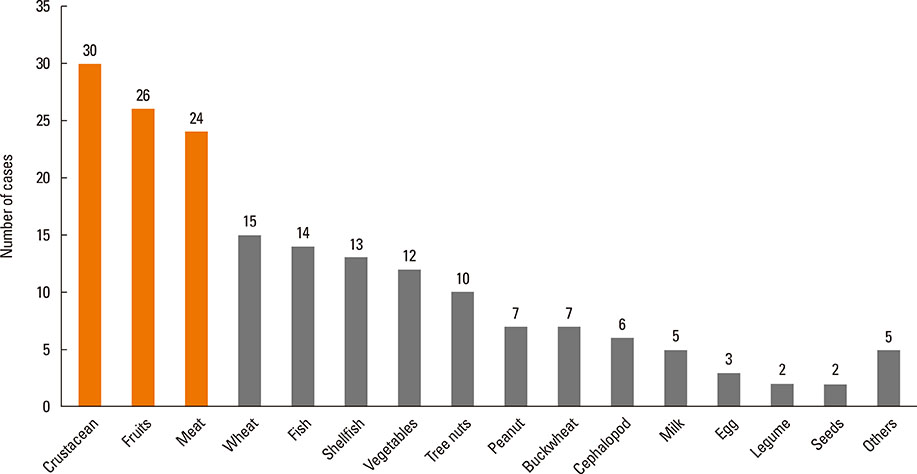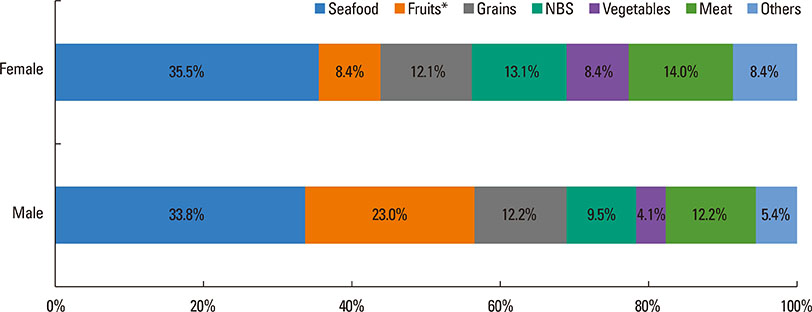A Retrospective Study of Korean Adults With Food Allergy: Differences in Phenotypes and Causes
- Affiliations
-
- 1Department of Allergy and Clinical Immunology, Ajou University School of Medicine, Suwon, Korea. ye9007@ajou.ac.kr
- 2Department of Pediatrics, Ajou University School of Medicine, Suwon, Korea. jsjs87@ajou.ac.kr
- KMID: 2421664
- DOI: http://doi.org/10.4168/aair.2017.9.6.534
Abstract
- PURPOSE
Increasing in prevalence, food allergy (FA) is becoming an important public health concern. In Korean adults, however, clinical phenotypes and causes of FA have not been studied. We aimed to study common causative allergens and clinical manifestations of FA in Korean adults.
METHODS
This study was conducted as a retrospective review of medical records for 95 patients (≥19 years old) diagnosed with FA from September 2014 to August 2015 at a single university hospital.
RESULTS
In the 95 patients, 181 FA events were recorded. The mean age of first onset of FA symptoms was 34.7±15.8 years. The most frequent causative food was seafood (34.8%); shrimp and crab allergies ranked highest, regardless of age and sex. Among all FA events, there were 47 (26.0%) cases of anaphylaxis and 26 (14.4%) cases of oral allergy syndrome (OAS). Seafood (51.1%) was the most frequent cause of anaphylaxis, followed by grains (14.9%). Most OAS cases were associated with fruits (95.7%). The frequency of fruit-induced FA was significantly higher in males than in females (23.0% vs 8.4%, P=0.011). While no cases of vegetables-induced FA were noted in younger individuals (19 to 30 years), vegetables accounted for 20.5% of FA symptoms in older subjects (≥51 years, P < 0.001). Allergic rhinitis (44.2%) and drug allergy (20.0%) were major comorbidities associated with FA. Overall, 29 FA events had cofactors, of which 10 were combined with exercise.
CONCLUSIONS
The major causes of FA in Korean adults were crustacean, fruits, and grains. Interestingly, the clinical manifestations of FA and demographics varied according to type of food allergen.
Keyword
MeSH Terms
Figure
Cited by 4 articles
-
Pollen-Food Allergy Syndrome in Korean Pollinosis Patients: A Nationwide Survey
Mi-Ae Kim, Dong-Kyu Kim, Hyeon-Jong Yang, Young Yoo, Youngmin Ahn, Hae-Sim Park, Hyun Jong Lee, Yi Yeong Jeong, Bong-Seong Kim, Woo Yong Bae, An-Soo Jang, Yang Park, Young-Il Koh, Jaechun Lee, Dae Hyun Lim, Jeong Hee Kim, Sang Min Lee, Yong Min Kim, Young Joon Jun, Hyo Yeol Kim, Yunsun Kim, Jeong-Hee Choi,
Allergy Asthma Immunol Res. 2018;10(6):648-661. doi: 10.4168/aair.2018.10.6.648.Clinical Features and Culprit Food Allergens of Korean Adult Food Allergy Patients: A Cross-Sectional Single-Institute Study
Sang Chul Lee, Sung-Ryeol Kim, Kyung Hee Park, Jae-Hyun Lee, Jung-Won Park
Allergy Asthma Immunol Res. 2019;11(5):723-735. doi: 10.4168/aair.2019.11.5.723.Subcutaneous Immunotherapy in Patients with Fagales Pollen-Induced Oral Allergy Syndrome
Nasil Kong, Sunyoung Kim, Sang Chul Lee, Kyung Hee Park, Jae-Hyun Lee, Jung-Won Park
Yonsei Med J. 2019;60(4):389-394. doi: 10.3349/ymj.2019.60.4.389.Clinical Manifestations and Risk Factors of Anaphylaxis in Pollen-Food Allergy Syndrome
Minji Kim, Youngmin Ahn, Young Yoo, Dong-Kyu Kim, Hyeon-Jong Yang, Hae-Sim Park, Hyun Jong Lee, Mi-Ae Kim, Yi Yeong Jeong, Bong-Seong Kim, Woo Yong Bae, An-Soo Jang, Yang Park, Young-Il Koh, Jaechun Lee, Dae Hyun Lim, Jeong Hee Kim, Sang Min Lee, Yong Min Kim, Young Joon Jun, Hyo Yeol Kim, Yunsun Kim, Jeong-Hee Choi,
Yonsei Med J. 2019;60(10):960-968. doi: 10.3349/ymj.2019.60.10.960.
Reference
-
1. Mullins RJ, Dear KB, Tang ML. Time trends in Australian hospital anaphylaxis admissions in 1998-1999 to 2011-2012. J Allergy Clin Immunol. 2015; 136:367–375.2. Sicherer SH, Sampson HA. Food allergy: epidemiology, pathogenesis, diagnosis, and treatment. J Allergy Clin Immunol. 2014; 133:291–307.3. Park M, Kim D, Ahn K, Kim J, Han Y. Prevalence of immediate-type food allergy in early childhood in Seoul. Allergy Asthma Immunol Res. 2014; 6:131–136.4. Hong SJ, Ahn KM, Lee SY, Kim KE. The prevalences of asthma and allergic diseases in Korean children. Korean J Pediatr. 2008; 51:343–350.5. Branum AM, Lukacs S. Lukacs S, editor. Food allergy among U.S. children: trends in prevalence and hospitalizations. 2008. Atlanta (GA): Centers for Disease Control and Prevention.6. Sindher S, Fleischer DM, Spergel JM. Advances in the treatment of food allergy: sublingual and epicutaneous immunotherapy. Immunol Allergy Clin North Am. 2016; 36:39–54.7. Boyce JA, Assa'ad A, Burks AW, Jones SM, Sampson HA, Wood RA, et al. Guidelines for the diagnosis and management of food allergy in the United States: report of the NIAID-sponsored expert panel. J Allergy Clin Immunol. 2010; 126:S1–58.8. Song TW. Diagnostic decision points of specific ige titers in patients with food allergy: are they appropriate in all clinical settings. Allergy Asthma Immunol Res. 2015; 7:309–311.9. Kamdar TA, Peterson S, Lau CH, Saltoun CA, Gupta RS, Bryce PJ. Prevalence and characteristics of adult-onset food allergy. J Allergy Clin Immunol Pract. 2015; 3:114–115.10. Ben-Shoshan M, Harrington DW, Soller L, Fragapane J, Joseph L, St Pierre Y, et al. A population-based study on peanut, tree nut, fish, shellfish, and sesame allergy prevalence in Canada. J Allergy Clin Immunol. 2010; 125:1327–1335.11. Soller L, Ben-Shoshan M, Harrington DW, Fragapane J, Joseph L, St Pierre Y, et al. Overall prevalence of self-reported food allergy in Canada. J Allergy Clin Immunol. 2012; 130:986–988.12. Lee SY, Ahn K, Kim J, Jang GC, Min TK, Yang HJ, et al. A multicenter retrospective case study of anaphylaxis triggers by age in Korean children. Allergy Asthma Immunol Res. 2016; 8:535–540.13. Urisu A, Ebisawa M, Ito K, Aihara Y, Ito S, Mayumi M, et al. Japanese guideline for food allergy 2014. Allergol Int. 2014; 63:399–419.14. Kim SR, Park HJ, Park KH, Lee JH, Park JW. IgE sensitization patterns to commonly consumed foods determined by skin prick test in Korean adults. J Korean Med Sci. 2016; 31:1197–1201.15. Peters RL, Allen KJ, Dharmage SC, Lodge CJ, Koplin JJ, Ponsonby AL, et al. Differential factors associated with challenge-proven food allergy phenotypes in a population cohort of infants: a latent class analysis. Clin Exp Allergy. 2015; 45:953–963.16. Wu TC, Tsai TC, Huang CF, Chang FY, Lin CC, Huang IF, et al. Prevalence of food allergy in Taiwan: a questionnaire-based survey. Intern Med J. 2012; 42:1310–1315.17. Turner PJ, Gowland MH, Sharma V, Ierodiakonou D, Harper N, Garcez T, et al. Increase in anaphylaxis-related hospitalizations but no increase in fatalities: an analysis of United Kingdom national anaphylaxis data, 1992-2012. J Allergy Clin Immunol. 2015; 135:956–963.18. Ye YM, Kim MK, Kang HR, Kim TB, Sohn SW, Koh YI, et al. Predictors of the severity and serious outcomes of anaphylaxis in Korean adults: a multicenter retrospective case study. Allergy Asthma Immunol Res. 2015; 7:22–29.19. Wong L, Huang CH, Lee BW. Shellfish and house dust mite allergies: is the link tropomyosin? Allergy Asthma Immunol Res. 2016; 8:101–106.20. Versluis A, van Os-Medendorp H, Kruizinga AG, Blom WM, Houben GF, Knulst AC. Cofactors in allergic reactions to food: physical exercise and alcohol are the most important. Immun Inflamm Dis. 2016; 4:392–400.
- Full Text Links
- Actions
-
Cited
- CITED
-
- Close
- Share
- Similar articles
-
- The management of food allergy in Indonesia
- Food allergy: recent advances in pathophysiology and treatment
- Food Allergy: Diagnosis and Management
- The past, present, and future of the research on food allergy in Korean children
- Clinical Features of Adult Patients with Anaphylaxis Associated with Food in Gwangju and Chonnam Area



